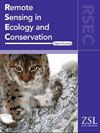降水和温度驱动撒哈拉以南非洲草原木本植被动态
IF 4.3
2区 环境科学与生态学
Q1 ECOLOGY
引用次数: 0
摘要
面对全球变化,确定生态系统动态的驱动因素以及响应在空间和时间上的变化是一项关键挑战。撒哈拉以南非洲的草原是至关重要的生态系统,通过放牧支持生物多样性、碳储存和生计。然而,尽管它们很重要,但驱动这些系统变化的过程仍然知之甚少,因为驱动因素之间的跨尺度相互作用产生了复杂的、依赖于环境的动态,这些动态随时间和空间的变化而变化。这对木本植被的动态尤其重要,因为这往往与退化过程(如木材侵蚀)有关,对生物多样性、饲料供应和火灾制度产生影响。本文利用卫星数据和结构方程模型,研究了1997-2016年降雨、温度、火灾和人口密度对非洲4个草原区(萨赫勒草原、大卡鲁和卡拉哈里旱地、东南亚亚热带草原和马达加斯加)木本植被动态的影响。在所有地区,降雨量与木本植被的增加一直呈正相关,而较高的温度与木本植被的减少有关,这表明水分供应促进了木本植物的生长,而干旱加剧则限制了木本植物的生长。出乎意料的是,火灾只在大卡鲁和喀拉哈里旱地对木材覆盖产生负面影响,而在马达加斯加,较高的温度和较高的人口密度减少了火灾;然而,这些关系并没有转化为对木本植被的显著间接影响。这些发现说明了环境和人为驱动因素塑造撒哈拉以南非洲草原木本植被动态的复杂方式。与热带稀树草原相比,火在草原中发挥的作用更弱,更具区域特异性,其与树木覆盖的反馈不太一致。降雨和温度的相反作用目前可能会限制木材的膨胀,但气候变化可能会破坏这种平衡,并进一步削弱火的有限调节作用。这些差异突出了针对草地系统独特的气候-植被动态制定管理策略的必要性。本文章由计算机程序翻译,如有差异,请以英文原文为准。
Precipitation and temperature drive woody vegetation dynamics in the grasslands of sub‐Saharan Africa
Identifying the drivers of ecosystem dynamics, and how responses vary spatially and temporally, is a critical challenge in the face of global change. Grasslands in sub‐Saharan Africa are vital ecosystems supporting biodiversity, carbon storage, and livelihoods through grazing. However, despite their importance, the processes driving change in these systems remain poorly understood, as cross‐scale interactions among drivers produce complex, context‐dependent dynamics that vary across space and time. This is particularly relevant for woody vegetation dynamics, which are often linked to degradation processes (e.g., woody encroachment), with consequences for biodiversity, forage availability, and fire regimes. Here, we used satellite data and structural equation models to investigate the effects of rainfall, temperature, fire, and population density on woody vegetation dynamics in four African grassland regions (the Sahel grasslands, Greater Karoo and Kalahari drylands, Southeast African subtropical grasslands, and Madagascar) during 1997–2016. Across all regions, rainfall was consistently positively correlated with increased woody vegetation, while higher temperatures were associated with decreased woody vegetation, suggesting that water availability promotes woody plant growth, whereas rising aridity limits it. Unexpectedly, fire had a negative effect on woody cover only in the Greater Karoo and Kalahari drylands, while in Madagascar, higher temperatures and greater population density reduced fire; yet these relationships did not translate into significant indirect effects on woody vegetation. These findings illustrate the complex ways by which environmental and anthropogenic drivers shape woody vegetation dynamics in grasslands across sub‐Saharan Africa. Compared to savannas, fire plays a weaker and more region‐specific role in grasslands, where its feedback with woody cover is less consistent. The opposing effects of rainfall and temperature may currently constrain woody expansion, but climate change could disrupt this balance and further weaken fire's limited regulatory role. These differences highlight the need for management strategies tailored to the distinct climate–vegetation dynamics of grassland systems.
求助全文
通过发布文献求助,成功后即可免费获取论文全文。
去求助
来源期刊

Remote Sensing in Ecology and Conservation
Earth and Planetary Sciences-Computers in Earth Sciences
CiteScore
9.80
自引率
5.50%
发文量
69
审稿时长
18 weeks
期刊介绍:
emote Sensing in Ecology and Conservation provides a forum for rapid, peer-reviewed publication of novel, multidisciplinary research at the interface between remote sensing science and ecology and conservation. The journal prioritizes findings that advance the scientific basis of ecology and conservation, promoting the development of remote-sensing based methods relevant to the management of land use and biological systems at all levels, from populations and species to ecosystems and biomes. The journal defines remote sensing in its broadest sense, including data acquisition by hand-held and fixed ground-based sensors, such as camera traps and acoustic recorders, and sensors on airplanes and satellites. The intended journal’s audience includes ecologists, conservation scientists, policy makers, managers of terrestrial and aquatic systems, remote sensing scientists, and students.
Remote Sensing in Ecology and Conservation is a fully open access journal from Wiley and the Zoological Society of London. Remote sensing has enormous potential as to provide information on the state of, and pressures on, biological diversity and ecosystem services, at multiple spatial and temporal scales. This new publication provides a forum for multidisciplinary research in remote sensing science, ecological research and conservation science.
 求助内容:
求助内容: 应助结果提醒方式:
应助结果提醒方式:


